Holiday cookie recipes: Whole grain gingerbread men and more
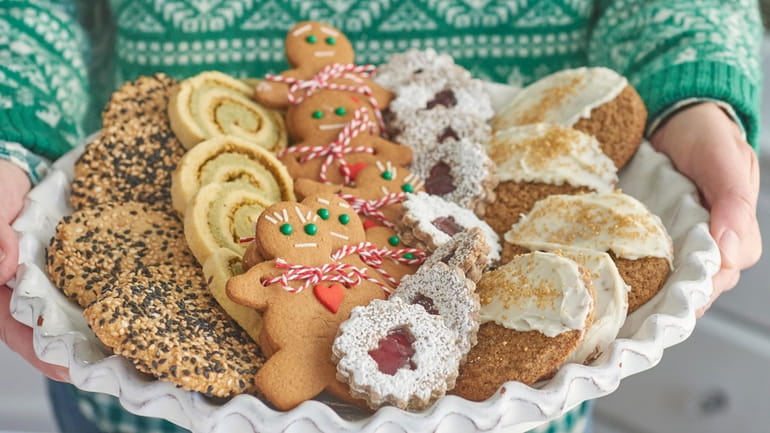
Whole grain cookies with alternative flours and grains such as whole wheat, almond, buckwheat, cornmeal and rye. Credit: Doug Young
There are many reasons to try whole grain baking this holiday season, not the least of which is the availability of a stunning range of alternative and whole grain flours now available at supermarkets across Long Island. At the Cutchogue King Kullen where I shop, I can now buy flour milled from whole wheat, millet, semolina, almonds, chickpeas, rice, sorghum, spelt, and other grains, nuts, and legumes.
It’s not just availability that makes me want to bake buckwheat brownies or amaranth shortbread. While all-purpose flour gives structure to baked goods, its neutral flavor doesn’t lend much pizzazz. If iced sugar cookies are sounding a little one-note as you gear up for holiday baking, look no further than the natural foods aisle to create a symphony of flavors on your cookie platter. Stone-ground cornmeal gives pistachio pinwheels a corny sweetness as well as beautiful sandy texture and bright color. Rye provides earthy counterbalance to the robust spices in molasses cookies. Almond flour ups the nutty intensity of gluten-free tahini and sesame seed cookies.
Flavor is not all you’ll be getting when you make your cookies with these flours. Buckwheat is rich in fiber, potassium, phosphorus, magnesium, and copper. Rye is lower on the glycemic index than all-purpose flour, and contains an abundance of iron and B vitamins. In general, it’s a smart idea to cook with a variety of whole foods to cover all of your nutritional bases. If you explore the range of whole grain and alternative flours while baking cookies for friends and family this year, you’ll be giving them the gift of micronutrients as well as holiday cheer.
Whole Wheat Gingerbread Men
Makes about thirty-six 4-inch gingerbread men
Chances are good that your friends and family will never notice the fiber-rich whole wheat flour in these cookies, because it harmonizes so well with dark and spicy flavors of molasses and ginger. You can decorate them with royal icing, but I like a more minimalist approach — a few sugar décors or maybe some currants or mini chocolate chips — to keep the focus on the fragrant cookie itself.
1/2 cup (1 stick) unsalted butter, softened
1/2 cup sugar
1 teaspoon baking powder
1 teaspoon ground ginger
1/2 teaspoon baking soda
1/2 teaspoon salt
1/2 teaspoon ground cinnamon
1/4 teaspoon ground cloves
1/2 cup dark (not light or blackstrap) molasses
1 large egg
1 tablespoon white vinegar
1 ¼ cups unbleached all-purpose flour
1 ¼ cups whole wheat flour
Sugar décors
1. Combine the butter and sugar in a large mixing bowl in a large mixing bowl with an electric mixer on medium-high speed until well-combined.
2. Add the baking powder, ginger, baking soda, salt, cinnamon and cloves, and beat until incorporated.
3. Add the molasses, eggs, and white vinegar and beat until smooth, scraping down the sides of the bowl once or twice as necessary.
4. Add the white flour, 1⁄4 cup at a time, and stir until incorporated. Repeat with whole wheat flour. Scrape half of the dough onto a sheet of plastic wrap and press into a 5-inch disk. Repeat with the remaining half of the dough. Refrigerate for at least 1 hour and up to 3 days.
5. Preheat the oven to 375 degrees. Line a baking sheet with parchment paper.
6. Roll out the dough on a lightly floured work surface to a 1/8-inch thickness. Use a 4-inch gingerbread man cookie cutter to cut the dough, rerolling and cutting the scraps. Place the cookies on the baking sheet. Make eyes, nose, mouth, and buttons by pressing sugar décors or chocolate chips. Cut out holes in each cookie with a skewer or drinking straw for bakers twine or ribbon if desired.
7. Bake the cookies until they are firm, 8 to 10 minutes. Transfer to a wire rack and let cool completely. Cookies will keep at in an airtight container at room temperature for up to 1 week.

Whole wheat gingerbread men cookies. Credit: Doug Young
Tahini Cookies
Makes 24 cookies
This is a great vegan and gluten-free option for the holidays. Tahini, a nut butter made from ground sesame seeds and used in Middle Eastern cooking, gives these cookies a boldly nutty flavor. Almond flour gives them a tender texture. And a combination of black and white sesame seeds give them crunch and a visual pop.
1/3 cup black sesame seeds
1/3 cup white sesame seeds
3 cups almond flour
1 teaspoon baking soda
1/2 teaspoon salt
2/3 cup honey
2/3 cup tahini
2 teaspoons pure vanilla extract
1. Preheat the oven to 350 degrees. Line 2 baking sheets with parchment paper. Stir together the sesame seeds in a small bowl.
2. In a medium bowl, whisk the almond flour with the baking soda and salt. In a large bowl, use an electric mixer to the honey with the tahini and vanilla extract until smooth. Add the almond flour mixture, ½ cup at a time, to the honey mixture and mix until well-combined.
3. Using a 1 1/2-inch scoop, scoop the dough into balls. Roll the balls in the sesame seeds to completely coat, then flatten them into 1/4-inch-thick rounds.
4. Transfer the rounds to the baking sheets, 2 inches apart.
5. Bake until bottoms of cookies are golden about 10 minutes total. Let stand on baking sheets for 15 minutes, transfer to a wire rack, and let cool completely. Tahini Cookies will keep in an airtight container at room temperature for 4 to 5 days.
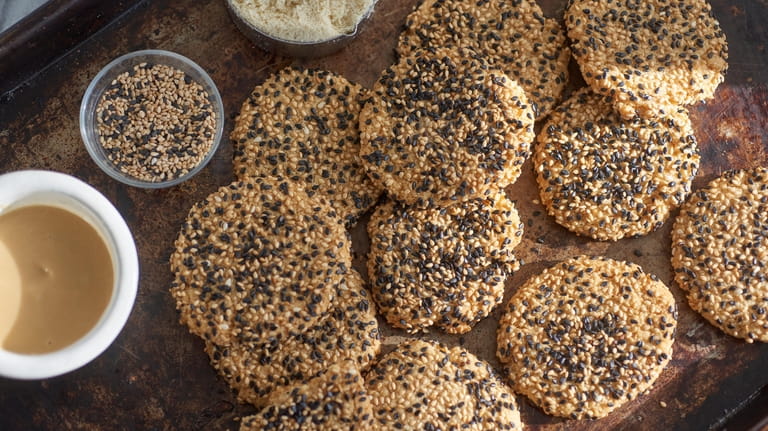
Tahini cookies. Credit: Doug Young
Buckwheat Linzer Cookies
Makes about 75 small sandwich cookies
The rich and robust flavor of buckwheat is a great match for hazelnuts and jam in this nontraditional Linzer cookie.
1 cup skinned hazelnuts
2/3 cup sugar
1 cup (2 sticks) unsalted butter, softened
1 large egg yolk
1 teaspoon pure vanilla extract
2 cups unbleached all-purpose flour plus extra for working the dough
2/3 cups buckwheat flour
¼ teaspoon salt
¼ cup raspberry jam
Confectioners’ sugar for dusting
1. Place the hazelnuts and 1/3 cup of the sugar in a food processor and process until just finely ground.
2. Cream the butter and the remaining 1/3 cup of the sugar together in a large mixing bowl with an electric mixer on medium-high speed until fluffy. Add the egg yolk and vanilla and beat until incorporated. Add the flour, buckwheat flour, salt, and hazelnut mixture and mix on low speed until the dough comes together in a ball.
3. Press the dough into three 1/2-inch-thick disks, wrap in plastic, and refrigerate for at least 2 hours and for up to 2 days. (The dough can be frozen for up to 1 month; defrost it in the refrigerator before use.)
4. Preheat the oven to 350 degrees. Line a baking sheet with parchment paper. Remove one of the dough disks from the refrigerator and knead it 4 or 5 times on a lightly floured work surface to soften it. With a lightly floured rolling pin, roll out the dough a scant 1/4 inch thick. Use a 2-inch round cutter to cut out as many circles as you can. Use a 1-inch tree- or bell-shaped cutter to cut tree shapes into the center of half of the cookies (sets of Linzer cookie cutters are available online with small holiday shapes inside of round shapes, that make cutting simpler).
5. Place the cookies on the prepared pan and bake until just browning around the edges, 10 to 12 minutes. Slide the entire parchment sheet with the cookies onto a wire rack and let the cookies cool completely. Repeat with the remaining disks of dough, and rerolling the excess dough from the cutouts, using fresh parchment paper.
6. To assemble the cookies, use a small offset spatula to spread about 1/4 teaspoon of jam on uncut to within 1/8 inch of the edges of the cookie. Lightly sift some confectioners’ sugar over the cutout cookies. Place a cutout round on top of a jam-covered round. Buckwheat Linzer Hearts will keep in an airtight container for up to 2 days.
Note: Skinning Hazelnuts
There are two ways to skin hazelnuts: Roast them in a 325 degree oven for 15 to 20 minutes, wrap them in a clean kitchen towel to steam for a few minutes, and then rub them vigorously while they’re still inside the towel until the skins fall away. Alternatively, place the hazelnuts in a saucepan and cover with an inch of water. Add a tablespoon of baking soda and bring to a boil for 3 minutes. Strain the nuts under cold running water, rubbing them between your palms to remove the skins. If you want to bring out their flavor, roast the skinned nuts in a 325 degree oven for 15 minutes or so.
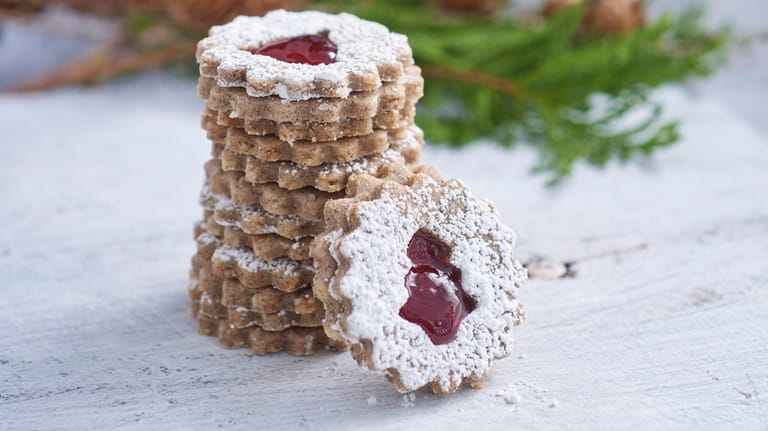
Buckwheat linzer cookies. Credit: Doug Young
Cornmeal and Pistachio Pinwheels
Makes 32 cookies
Cornmeal gives these cookies a pleasantly crunchy texture and beautiful yellow hue. Stone-grinding ensures that fiber and healthy oils from the hull and germ of the corn remain after processing. Adding some matcha powder to half of the dough won’t change its flavor, and is a great way to add vivid green color naturally.
1/3 cup shelled pistachio nuts
1 cup all-purpose unbleached flour
1 cup yellow cornmeal, preferably stone-ground
1/4 teaspoon salt
10 tablespoons unsalted butter, softened
¾ cup sugar
1 large egg
1/2 teaspoon pure vanilla extract
1 ½ teaspoons matcha tea powder
1. In a food processor, pulse the pistachios until they’re finely ground. Transfer to a small bowl and set aside.
2. Combine flour, corn meal and salt in a medium mixing bowl.
3. Combine butter and sugar in a large mixing bowl and cream together with an electric mixer on medium-high speed until fluffy, 2 to 3 minutes. Add egg and vanilla and beat until smooth. Add the flour mixture, ½ cup at a time, and mix until well-combined.
4. Remove half of the dough from the mixer and leave half of the dough in the bowl. Beat in the matcha powder into the remaining dough until evenly colored.
5. Spread a large piece of plastic wrap on a work surface and sprinkle lightly with flour. Use a rolling pin to roll the yellow dough into an 8 ½-inch square, using a small offset spatula to straighten and neaten the edges. Repeat with the green dough on another piece of plastic.
6. Lightly brush the yellow dough with water and sprinkle evenly with the chopped pistachios, pressing them lightly into the dough so they adhere. Carefully invert the green dough onto the yellow dough so that the two doughs are lined up, one on top of the other. Use the plastic wrap to push and roll the doughs into a neat, tight log. Tightly wrap in plastic wrap and freeze until firm, at least 2 hours and up to 1 month.
7. Preheat oven to 350 degrees. Slice the dough into 1/4-inch-thick rounds. Place cookies on parchment-lined baking sheets at least 2 inches apart. Bake them until they are pale golden around edges but still soft on top, 10 to 12 minutes. Let them stand on baking sheet for 5 minutes and then remove t with a metal spatula to a wire rack to cool completely. Cornmeal and Pistachio Pinwheels will keep in an airtight container at room temperature for 2 to 3 days.
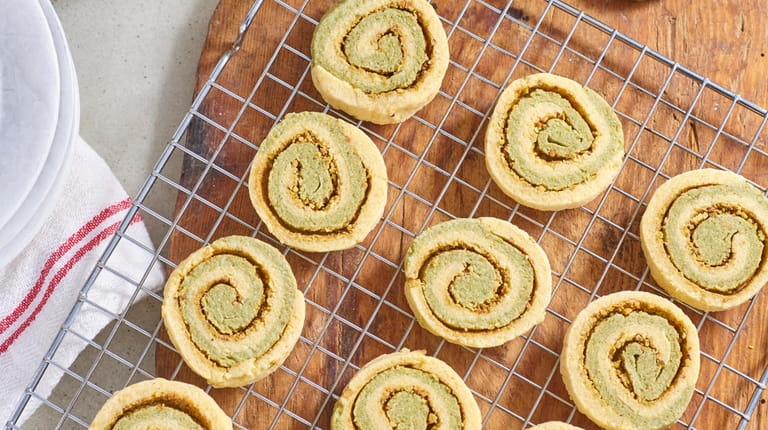
Cornmeal and pistachio pinwheels. Credit: Doug Young
Rye Molasses Cookies
Makes about 30 cookies
Rye flour is a baking staple across Scandinavia and Eastern Europe, where rye grows well in cold weather. Not surprisingly, holiday cookies from Sweden to Siberia have featured rye for centuries.
2 2/3 cups dark
rye flour
1 teaspoon ground ginger
1 teaspoon ground cinnamon
½ teaspoon ground cardamom
½ teaspoon salt
½ teaspoon baking soda
¾ cup (1 ½ sticks) unsalted butter, softened
1 cup sugar
¼ cup dark (not light or blackstrap) molasses
2 large eggs
4 ounces white candy melts, melted
Sugar décors
1. Preheat the oven to 350 degrees.
2. Combine the rye flour, ginger, cinnamon, cardamom, salt and baking soda in a medium mixing bowl.
3. Cream the butter, sugar and molasses together in a large mixing bowl with an electric mixer on medium speed until smooth. Add the eggs and beat until smooth. Stir in the rye flour mixture until just combined. Place the bowl in the refrigerator for 10 minutes (or up to 6 hours) to let the dough firm up.
4. Drop the batter by heaping tablespoonfuls (or use a cookie scoop) onto parchment-lined baking sheets, leaving about 2 inches between each cookie. (Balls of dough may be placed next to each other on parchment-lined baking sheets, frozen, transferred to zipper-lock plastic freezer bags, and stored in the freezer for up to 1 month. Frozen cookies may be placed in the oven directly from the freezer and baked as directed.) Bake the cookies until the edges are firm but the tops are still soft, 12 to 14 minutes. Let them stand on the baking sheet for 5 minutes and then carefully slide the entire parchment with the cookies from the pan to a wire rack to let them cool completely.
5. Use a small metal spatula to spread the white candy melts over 1/3 of the top of each cookie, sprinkling with sugar décors as you work. Let stand until the topping is firm, 30 minutes. Cookies will keep in an airtight container at room temperature for 2 to 3 days.
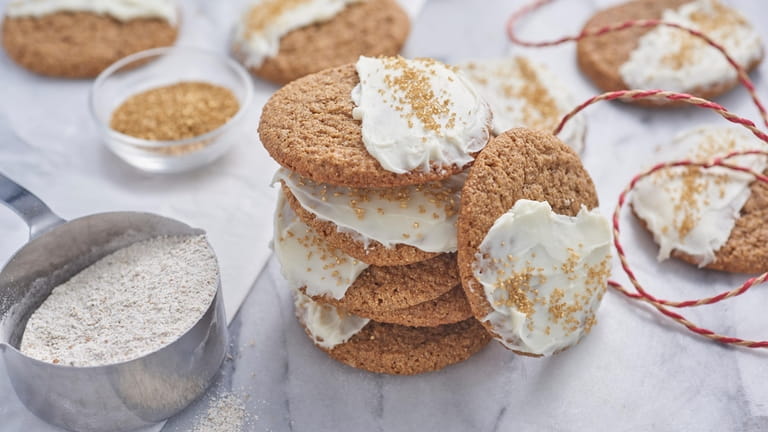
Rye molasses cookies. Credit: Doug Young
HOW TO SWAP FLOUR IN A RECIPE
There are three things to consider when adapting a favorite cookie recipe to include an alternative flour:1.
FLAVOR: Rye flour might be too assertive in mild and delicate vanilla shortbread cookies. Earthy teff flour pairs well with rich, deeply flavored ingredients like chocolate, coffee, and nuts. A little bit of online research before you shop will help you determine which flours to choose for experimentation.
TEXTURE: Gluten is the web of protein strands that form when flour is mixed with a liquid. It provides the structure that allows baked goods to rise high in the oven without falling. Because alternative flours don’t develop nearly as much gluten, if any, as wheat flour, they won’t provide as strong of a web. It is tricky to simply substitute, say, rye flour for wheat flour in a cake or bread recipe. With less gluten, your cake or bread is likely to be heavier and flatter than you would like. If you try to use a flour with no gluten, like almond flour, your cake or bread won’t rise at all. Luckily for holiday cookie bakers, low- and no-gluten flours will work just fine in most cookies, which are, after all, supposed to be flat. But cookies made with no- or low-gluten flour tend to crumble; not a great quality, especially if you’d like to pack yours up for gift-giving. Start by substituting just 25% of the wheat flour in your recipe with an alternative flour, and then increasing the percentage in subsequent batches if you feel the dough will be strong enough.
LIQUID: Alternative flours differ in how much liquid they will absorb. Spelt flour doesn’t absorb as much liquid as wheat flour, so you might adjust the amount of liquid you are adding to a recipe to avoid an overly sticky or loose dough. Whole wheat, buckwheat, and rye generally will absorb more water than white flour, so adjust accordingly.
